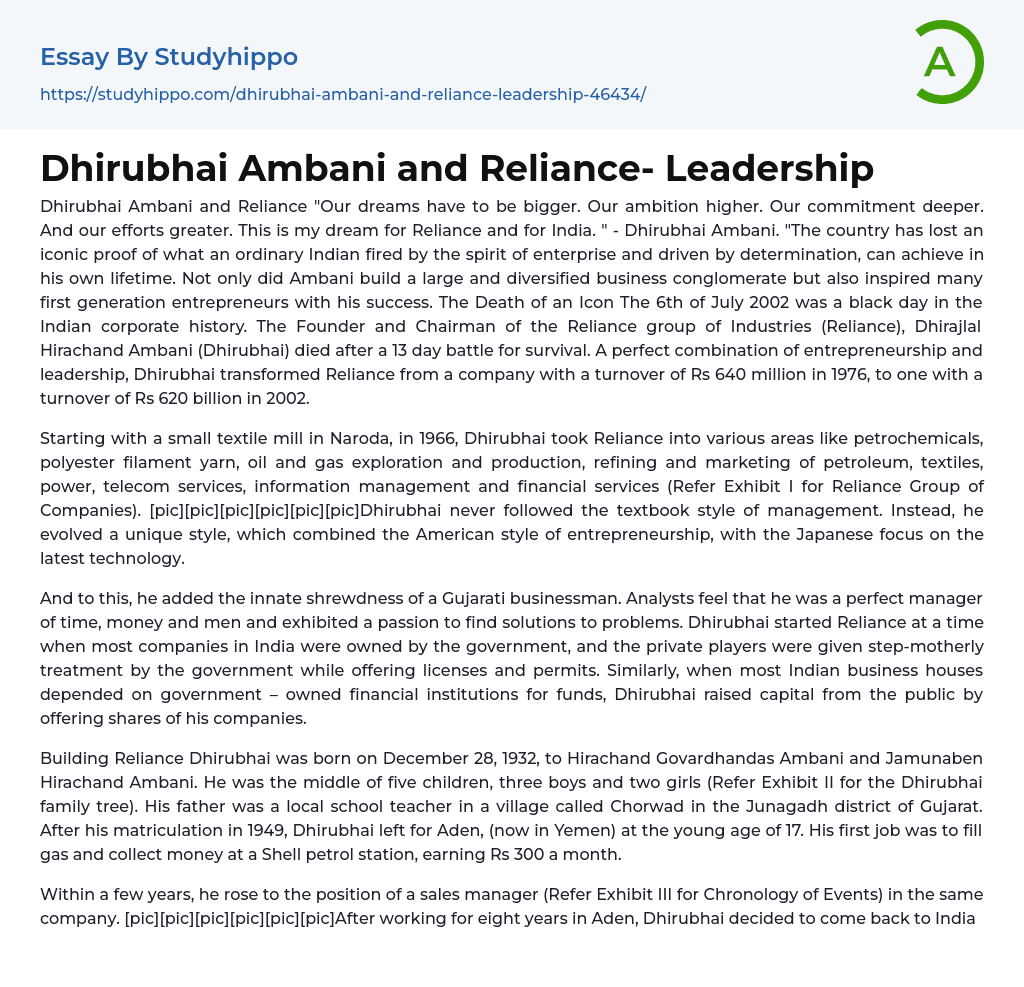Dhirubhai Ambani and Reliance "Our dreams have to be bigger. Our ambition higher. Our commitment deeper. And our efforts greater. This is my dream for Reliance and for India. " - Dhirubhai Ambani. "The country has lost an iconic proof of what an ordinary Indian fired by the spirit of enterprise and driven by determination, can achieve in his own lifetime. Not only did Ambani build a large and diversified business conglomerate but also inspired many first generation entrepreneurs with his success. The Death of an Icon The 6th of July 2002 was a black day in the Indian corporate history. The Founder and Chairman of the Reliance group of Industries (Reliance), Dhirajlal Hirachand Ambani (Dhirubhai) died after a 13 day battle for survival. A perfect combination of entrepreneurship and leadership, Dhirubhai transformed Reliance from a company with a turnover of Rs 640 million in
...1976, to one with a turnover of Rs 620 billion in 2002.
Starting with a small textile mill in Naroda, in 1966, Dhirubhai took Reliance into various areas like petrochemicals, polyester filament yarn, oil and gas exploration and production, refining and marketing of petroleum, textiles, power, telecom services, information management and financial services (Refer Exhibit I for Reliance Group of Companies). [pic][pic][pic][pic][pic][pic]Dhirubhai never followed the textbook style of management. Instead, he evolved a unique style, which combined the American style of entrepreneurship, with the Japanese focus on the latest technology.
And to this, he added the innate shrewdness of a Gujarati businessman. Analysts feel that he was a perfect manager of time, money and men and exhibited a passion to find solutions to problems. Dhirubhai started Reliance at
time when most companies in India were owned by the government, and the private players were given step-motherly treatment by the government while offering licenses and permits. Similarly, when most Indian business houses depended on government – owned financial institutions for funds, Dhirubhai raised capital from the public by offering shares of his companies.
Building Reliance Dhirubhai was born on December 28, 1932, to Hirachand Govardhandas Ambani and Jamunaben Hirachand Ambani. He was the middle of five children, three boys and two girls (Refer Exhibit II for the Dhirubhai family tree). His father was a local school teacher in a village called Chorwad in the Junagadh district of Gujarat. After his matriculation in 1949, Dhirubhai left for Aden, (now in Yemen) at the young age of 17. His first job was to fill gas and collect money at a Shell petrol station, earning Rs 300 a month.
Within a few years, he rose to the position of a sales manager (Refer Exhibit III for Chronology of Events) in the same company. [pic][pic][pic][pic][pic][pic]After working for eight years in Aden, Dhirubhai decided to come back to India and start something on his own. On December 31, 1958, he came back to Mumbai and started the Reliance Commercial Corporation (RCC) with a borrowed capital of Rs. 15,000. RCC was mainly involved in exporting commodities like ginger, cardamom, pepper, turmeric, and cashewnut. Using his connections in Aden, he exported a wide range of commodities to Aden.
Aden, being a free port attracted lot of exports. In the mid 1960s, the Government of India (GoI) introduced an export promotion scheme under which the earnings from the export of rayon fabrics
could be used for the import of nylon fiber. This attracted Dhirubhai's attention and he decided to switch from spices to textiles. In 1966, he set up a spinning mill at Naroda 20 kms from Ahmedabad with borrowed funds of Rs 2,80,000 and registered it (Reliance Textile Industries) as a powerloom unit with a paid up capital of Rs 150,000.
Another program, the High Unit Value Scheme introduced by the GoI in 1971 gave tremendous boost to Reliance textiles. The scheme allowed the import of polyester filament yarn against the export of nylon fabrics. RCC was benefited the most from this scheme and its exports constituted more than 60% of exports under this scheme. There were rumors that the scheme was solely devised for Dhirubhai. Dhirubhai strongly denied the allegations saying that Reliance cannot be blamed for taking advantage of the scheme 'when others kept their eyes shut. He said "I do not consider myself cleverer than my colleagues in the industry. If there was a very large margin of profit, why did they not take advantage of it? "1 When the High Unit Value scheme ended in 1978, Dhirubhai focused his attention on the domestic market. During this time, Reliance Textiles was not a very well known name in the domestic market. His first priority was to establish the Vimal2 brand, under which Reliance Textiles sold its fabrics in India.
An advertising programme was launched to facilitate its entry into the domestic market. [pic][pic][pic][pic][pic][pic]Dhirubhai knew that a strong brand image was crucial for winning the consumer's confidence. To achieve this objective, Reliance tried to emphasize the superior quality of its fabric in all its
advertisements. Besides this, Dhirubhai also took steps to develop an efficient distribution system for Vimal as he found that the existing marketing channels were inadequate and inefficient. However, things were not that easy.
- Being A Leader essays
- Servant Leadership essays
- Leadership Experience essays
- Leadership Qualities essays
- Board Of Directors essays
- Brand Management essays
- Business Ethics essays
- Business Management essays
- Change Management essays
- Comparative Analysis essays
- Decision Making essays
- Dispute Resolution essays
- Knowledge Management essays
- Leadership essays
- Leadership and Management essays
- Manager essays
- Operations Management essays
- Performance Management essays
- Product Management essays
- Project Management essays
- Quality Management essays
- Risk essays
- Risk Management essays
- Scientific Management essays
- Stress Management essays
- supply chain management essays
- Time Management essays
- Total Quality Management essays




